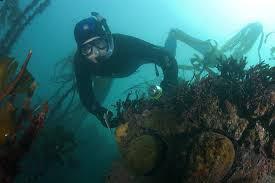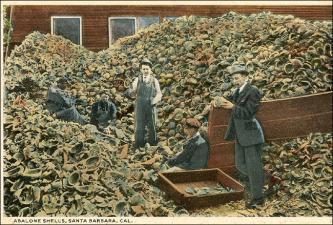Abalone - the mollusk we will soon only see on a postcard
 The South African abalone, Haliotis midae, is one of the largest molluscs on earth, attaining a weight of nearly 2kg and a ripe old age of 20 years.
The South African abalone, Haliotis midae, is one of the largest molluscs on earth, attaining a weight of nearly 2kg and a ripe old age of 20 years.
Abalone is shellfish of the univalve family, meaning they have only one shell, unlike bivalves such as clams that consists of 2 shells. Most abalone lives in shallow waters and grows very slowly. The inner shell of an abalone, which has an iridescent green, blue or pink shine, is a source of mother-of-pearl.

Mother–of-Pearl is the common name for nacre. Like pearls, nacre is secreted by the shells of the mantle tissue of certain species of mollusc. It is continuously deposited on the inner surface of the shell. This nacreous layer is commonly known as mother-of-pearl. It acts both as a means to smooth the shell itself and as a defence against parasitic organisms. Mother-of-Pearl is considered highly attractive by many cultures and is often used in making jewellery or as inlays in wood furniture or guitars.
 Abalone inhibits the kelp forests of the temperate west and south coasts and reaches densities of up to 50 individuals per square meter.
Abalone inhibits the kelp forests of the temperate west and south coasts and reaches densities of up to 50 individuals per square meter.
Male abalone releases a cloud of sperm into the water, triggering the release of eggs by the female. For fertilization to take place, sperm and egg have to meet in the water column. Abalone reach sexual maturity at a small size, fertility is high and increase exponentially with size.
 They only start spawning from 10 years and the majority are poached even before they reach this age. A 1.5 inch abalone may spawn 10 000 eggs or more t a time while an 8 inch abalone may spawn 11million or more eggs. Abalone eggs and larvae are consumed by filter feeding fish and shellfish. Crabs and lobster predate on the juvenile abalone
They only start spawning from 10 years and the majority are poached even before they reach this age. A 1.5 inch abalone may spawn 10 000 eggs or more t a time while an 8 inch abalone may spawn 11million or more eggs. Abalone eggs and larvae are consumed by filter feeding fish and shellfish. Crabs and lobster predate on the juvenile abalone Abalone shells are rounded or oval with a large dome towards one end. The shell has a row of respiratory pores.
Abalone shells are rounded or oval with a large dome towards one end. The shell has a row of respiratory pores.
The muscular foot has strong suction power permitting the abalone to clamp tightly to rocky surfaces.

What is Aquaculture?
One way of sustaining the abalone without plundering the ocean is to establish abalone farms. Abalone are naturally adapted to turbulent open sea conditions and can only be held in circulating, high-quality, well-oxygenated, fully marine salt water. In land-based abalone aquaculture, oceanic water is flushed through a system of plastic trays, or concrete raceways via pumps. This control of environmental factors optimize growth rates, whilst minimize any potential environmental impacts.

Article first appeared in Marine Wildlife Magazine
Call us and schedule your listing today! Contact Us
Copyright © 2025 Hermanus Online Magazine. Web Development by Jaydee media.

